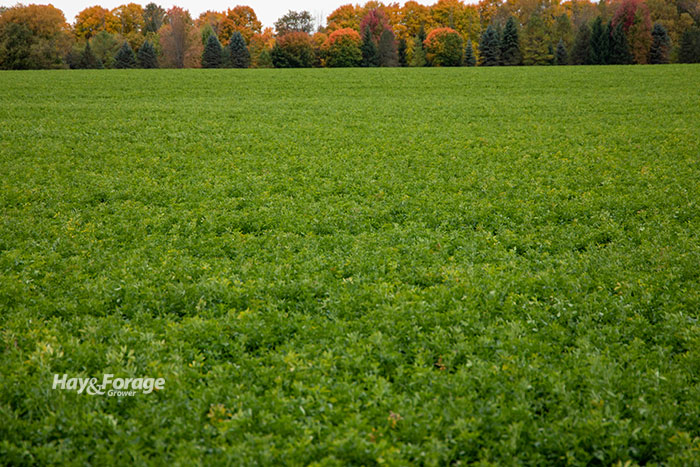
The calendar has flipped to October, and I’m sure a lot of farmers have already mothballed their hay equipment. I also know there are plenty of farmers who are at least thinking about an extra cutting of alfalfa, if not already making plans for it.
After a killing freeze, alfalfa quits growing. Conventional wisdom is that this is a safer time to cut than four to six weeks before a growth-stopping frost or freeze. With the late-fall cut, plants are unlikely to use stored root reserves to initiate new growth.
To be sure, growing seasons are longer than they used to be. There are also many areas of the U.S. that are finally getting consistent rain, if not too much. These factors may add to dry matter accumulation, but it may still be not enough to make an extra late-fall cutting a winning economic strategy. There are several reasons for this.
Yields of alfalfa after a killing frost are typically low; they will be even lower if the cutting height is raised to help catch snow, as is often recommended. Alfalfa fields in the fall present a deceiving appearance. What looks like a bumper crop can seemingly disappear through the mower-conditioner. During my experience in Wisconsin of measuring late-fall cuttings, rarely did fields yield over a half ton per acre. This puts the harvest cost per ton through the roof.
Also consider that fields cut in late fall generally break dormancy later during the following spring and have a lower first-cut yield compared to not being fall cut. Research had shown that the gain in fall yield is about equal to the loss in spring yield. This is not to say that the fields are winter injured; rather, they are just less vigorous come spring.
Leaving the fall aftermath growth over winter is beneficial to not just catching and holding snow cover, but it also has the effect of moderating soil temperature fluctuations during winter and early spring. It is extreme soil temperature fluctuations that may cause alfalfa to break dormancy too early or cause plant heaving. This soil temperature moderation is beneficial both during a winter warm snap and in times of polar vortexes.
Why do it?
In my experience, there are three primary reasons why farmers cut alfalfa late in the fall. First, they don’t like to waste perfectly good forage. In the case where favorable weather has contributed to significant fall growth, it’s hard to leave an apparent high-yielding, high-quality crop out in the field, but in reality, it most likely isn’t high yielding. That said, a late fall-cut forage is almost always excellent quality. With the extended cool temperatures, there is low lignin deposition and fiber digestibility is tremendous.
There’s been a long-held concern by some farmers that fall alfalfa growth will smother and kill a stand over winter. This simply does not happen with a legume such as alfalfa. Rather, leaves freeze and eventually drop off the plant. Stems, for the most part, stand erect. The old, fall aftermath growth may impact forage quality in the next year’s first cutting, but if harvested early enough, the reduction in quality is minimal.
Following a year of severe winterkill, drought, or excessive rainfall, sometimes alfalfa is cut in late fall simply to meet a need for additional high-quality feed. It’s difficult to be critical of this thinking, but it will remain expensive forage.
If you’re currently weighing the decision of whether to cut or not, consider the condition of the alfalfa stand before greasing the mower. If it’s already been stressed by intensive cutting, pest issues, or low soil fertility, stress from an additional cutting will likely accelerate stand decline. All factors considered, the need for feed prior to the next year’s harvest may be the only good reason to cut Halloween hay.

